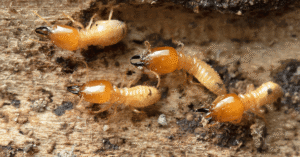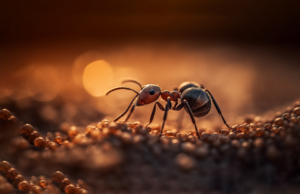Cockroaches. The mention of cockroaches alone creates discomfort, particularly in Florida, where these hard-to-eliminate pests thrive frequently. Many people encounter cockroaches flocking to their kitchens. Cockroaches choose Florida kitchens because of the warm climate and substantial food and water availability.
This blog explores cockroaches in Florida: Why they love your kitchen while addressing their invasion factors and presenting effective control methods.
The Cockroach Problem in Florida
Different species of cockroaches exist in Florida, with the American and German cockroaches joined by the palmetto bug (a flying cockroach also known by its name). The southeastern heat combined with moisture conditions in Florida establishes an ideal atmosphere for pest breeding. The environmental conditions of high humidity and warm temperatures create favourable conditions throughout the year for cockroaches to multiply.

The climate in this area attracts homes as suitable spaces, while kitchens become the most sought-after locations. Easy access to food, while water and dark nooks provide perfect hiding areas, attracts cockroaches to your kitchen space. Knowing how Florida’s environmental elements support cockroach population growth will help prevent such infestations. Cockroaches prefer your kitchen space because it has a tremendous appeal for them.
Food Residue and Accessibility
Cockroaches are opportunistic eaters, accepting any type of food available to them. Small pieces of food debris found on countertops, stove grease, and food remnants in sink areas attract cockroaches into your home. Eliminating food residues through proper storage severely increases the likelihood of cockroach infestation, and exposed trash exposes homes to these pests.
The kitchen contains numerous available storage areas for food items. Cockroaches automatically seek out pantry cabinets and scattered sugar containers that lack proper sealing. The food supply from cardboard boxes and paper bags works in two ways: cockroaches use them to obtain food and shelter.
Moisture and Water Sources
Kitchens contain various water sources that cockroaches need to preserve their existence. It is nearly impossible for cockroaches to avoid kitchen environments with leaky faucets, condensed water, and sink drains with water left overnight. The excessive moisture in Florida kitchens gives cockroaches additional opportunities to multiply effectively.
Cockroaches’ water resistance remains strong among their biological capabilities. A cockroach requires water for survival for a maximum of three days, while it can go without food for up to three weeks. Your kitchen sink supplies, dishwasher, and wet sponges are critical for cockroaches’ survival.
Warm, Quiet Hiding Spots
Cockroaches favour concealed, dark locations and warmth, which grants them daytime protection. Kitchens provide numerous nesting places, including the rear sections of cabinets and tight areas between kitchen appliances, such as refrigerators and ovens.
Hidden cockroach entry points and shelters are easily developed through wall cracks, gaps around pipes, and holes near baseboards. Observing a cockroach during the daytime indicates severe overcrowding of hiding spots and warns about a possible infestation.
The Lifecycle and Rapid Reproduction of Cockroaches
Rapid reproduction is one main reason cockroaches are so challenging to manage. Each female roach produces hundreds of offspring within just a few months of her life. Extremely favourable Florida environmental circumstances, consisting of vibrant temperatures and abundant moisture, fast-track the cockroach reproduction process.
Knowledge about their life cycle helps to achieve control. The hidden cockroach egg nests in dark areas produce nymphs that immediately search for food while looking for water sources. Maturing cockroaches perform the lifecycle again, which creates an exponential population increase when no controlling measures are implemented.
How to Spot the Signs of a Cockroach Infestation
Spotting cockroaches isn’t always straightforward. These pests spend their nights active and are skilled at concealing their location. Several distinct indications of kitchen cockroach infestation exist, which you should look out for.
- Droppings: Small, dark droppings are scattered near hiding spots.
- Egg Casings: Empty egg capsules (oothecae) near dark corners or cracks.
- Unpleasant Odour: A musty smell that grows stronger with larger infestations.
- Sightings: Spotting live roaches during the day usually suggests a severe infestation.
Identifying these signs early can help you address the problem before it escalates.
How to Keep Cockroaches Out of Your Kitchen
Store Food Securely
Cockroach prevention around the kitchen starts with removing all available food resources. All pantry food, including cereal and flour, should stay in airtight and sealed containers. You should also avoid overnight food exposure and execute immediate intermittent cleaning of food messes.
Check all your pantry storage points for weaknesses, such as open sugar packages and torn cereal boxes. Modifying food storage methods reduces cockroaches’ food-seeking behaviour.
Eliminate Water Sources
Perform repairs right away to address all leaking household water supplies throughout the kitchen. The sink needs immediate drying, with regular attention paid to removing wet dishes and sponges from the sink at night. A quick routine of area drying minimizes the attraction cockroaches feel towards your kitchen.
Purchasing a dehumidifier becomes essential for kitchen moisture reduction because humidity levels remain high in Florida’s summer months.
Seal Entry Points
Seal-offs prove highly effective in preventing cockroaches from entering living spaces. Survey your kitchen for every window and door space to check for holes and examine all pipes for leakage. Apply weatherstripping and caulk to block openings in your house. This step serves both cockroaches and multiple pest species prevention.
The most common cockroach entry points are under sinks and the base of appliances, so homeowners should pay extra attention to these zones in their preventive measures. Long-term control depends on a routine inspection method that includes sealing new openings.
Regular Cleaning and Maintenance
The most effective method to stop cockroaches from infesting your home involves keeping your kitchen spotless. Regular cleaning includes sweeping, vacuuming the floor and using disinfectant to clean countertops. It’s essential to detail the cleaning of inaccessible areas, including furniture areas beneath appliances and inside cabinets.
Regular trash disposal, coupled with fitted lids on garbage bins, creates an environment hostile to pests. Frequent attention to cleaning and tidying activities, together with maintenance tasks, will make your kitchen uninviting to cockroaches.
When to Call a Professional
When faced with severe infestations, the solutions you find online may not succeed in eliminating the problem. A professional pest control service must be called when you see many cockroaches each day and find egg casings.
Professional exterminators utilize specialized tools and treatments to deliver effective solutions to eradicate cockroaches from their source. Your home needs unique prevention strategies, which you can obtain from their expert advice about cockroach control methods.
Conclusion
The state of Florida welcomes cockroaches into its kitchens, although your household does not have to share this attraction with these pests. Understanding their preferences and proactively executing preventive measures will establish your kitchen as a territory they cannot access.
Check all tiny details within your space, especially food storage areas, sources of water supply, and concealed entries. Simple house maintenance, including periodic cleaning and crack filling, can effectively stop cockroach infestations. If possible remedies do not work, then call in professional help to get your kitchen back.
A specific plan combined with dedication will ensure that your space remains cockroach-free, enabling you to achieve a comfortable, clean, and inviting living environment.







